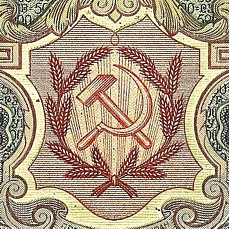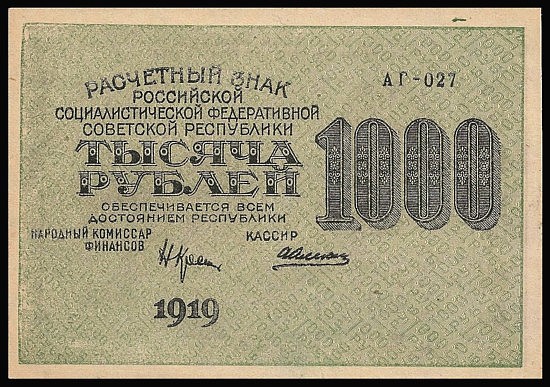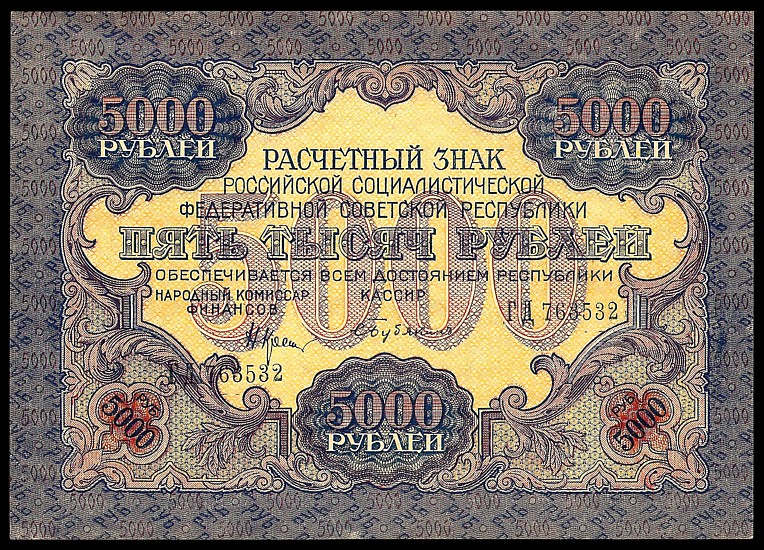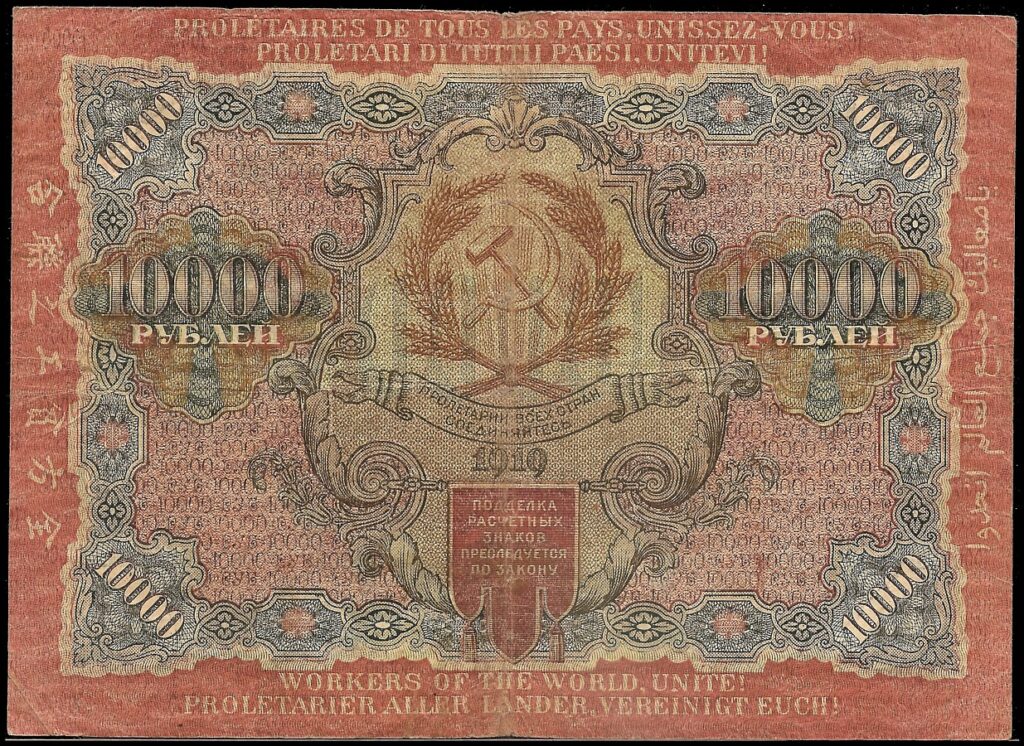RUSSIA
“Babylonian Notes”

This note issued in 1919 is also known widely, in common parlance, as the “Babylonian Note”, due to the seven different languages that are produced on this note. The languages are: Russian, English, German, French, Italian, Chinese, and Arabic. The message that is given in all these languages is: “WORKERS OF THE WORLD, UNITE!”
This revolutionary call for the working class to overthrow the ruling class was, even back in 1919, already an old message of an ideological form of government known as communism. This phrase became a mantra of adherents who had taken the message of Karl Marx, who wrote the Communist Manifesto in 1847. In his book, Marx had espoused that communism would help the working class (proletariat) by removing the ruling class (bourgeois), and all pretentions of class and provisions of rule, making everyone equal and sharing the whole of the product of the government. This communal life style is where Communism gets its name.
But there was much more to Marx’s Communist Manifesto than that. It is a relatively short work which, depending on the text and page size, is less than 70 pages. In his work, he explains the goals of communism and provides a general layout of the reasons that it must be undertaken as the natural evolution of government. The Manifesto does not hold back any punches. It lays all the blame on the bourgeois who, he stated, was the veritable slave master to the proletariat, paying them only enough to survive. He affirmed that the bourgeois were somewhat like a soulless monster, whose family was only of benefit as long as they were of use to make some form of profit. “The bourgeoisie has torn away from the family cell, and has reduced the family to a mere money relation“, he wrote. Marx advocated the abolition of the traditional family, because of the bourgeois ideal based on making profit from it.
And it didn’t end there, for as Marx wrote “No sooner is the exploitation of the laborer by the manufacturer, so far at an end, that he received his wages in cash, than he is set upon by the other portions of the bourgeoisie, the landlord, the shopkeeper, the pawnbroker, etc.” Here, Marx assuredly drew in the proletariat to a common theme, speaking to the common man, who always hates to pay out in cash the efforts of his labors. He further tells the readers that the bourgeois is not competent to rule due to their inability to provide for their “Slaves”.
Marx also defined communisms aim of forming the proletariat into a political party, and to take control of the government. He also stated that the most distinguishing feature of communism was the abolition of private property. He wrote: “In one word, you reproach us with intending to do away with your property. Precisely so; that is just what we have in mind”. But it must be understood that by private property, he meant only that “The distinguishing feature of communism is not the abolition of property generally, but the abolition of bourgeois property”. In this statement, Marx takes his targeted reader and promises him that he will only take away from those that have more than them, because he also tells them that the bourgeois has already been taking away from the proletariat. He insists that the bourgeois be eliminated and not allowed to surface in society again.
He set out 10 steps to achieve communism:
- Abolition of property
- Graduated income tax
- Abolition of inheritance
- Confiscation of emigrants property
- Combine banking into a national bank
- Nationalize communications and transportation
- Broaden the scope of national factories and farms
- Equality of labor by creating industrial “armies”
- Combine farming and manufacturing, spreading them throughout the country, spreading out the population
- Provide free government schools for children, tied to production
He also promised that the communists supported the revolution “against existing social and political order” and declared that the proletarians have nothing to lose but their chains. The last sentence in his manifesto was: WORKING MEN OF ALL COUNTRIES, UNITE!

Well, the Russians were ripe for a change in the early 1900’s and the communist ideal spoke loudly to them. The revolutionary words of Marx inspired them to fight against the Tsars and remove them from their palaces, making them all equal. This of course sounds great to a large, lower class of workers who were being used by the leader in just the way that Marx had wrote about. So the Soviet form of government, one set up by a ruling council, was set up in 1917 by the Bolsheviks in the Russian Civil War. Russia was renamed The Russian Socialist Federative Soviet Republic (RSFSR) in 1918. To promote the new form of government, and give the people a message of solidarity, “Workers of the World, Unite!” was printed on the banknotes issued by the new government. The Russian Civil War lasted until 1923, and the communist motto was added to the Soviet Coat of Arms. It continued the multi-language tradition set by the 1919 issue of banknotes, and had six languages made up from the countries that made the Soviet Union. As it grew, the Coat of Arms changed as well, adding more languages to represent the union. The last coat of arms the USSR had spelled out “Workers of the World, Unite!” in 15 different languages in the ribbons wrapped around the shafts of wheat.
Utopia is what they were after and, as it has in every single instance, it failed miserably. Perhaps Meriam Webster Dictionary says it best:
Utopia:
- a place of ideal perfection especially in laws, government, and social conditions.
- an impractical scheme for social improvement
- an imaginary and indefinitely remote place
‘Babylon’ notes were printed in 100, 250, 500, 1000, 5000 and 10000 Ruble denominations. Below are the three highest denominations. In reality, each note is larger than the previous note.





